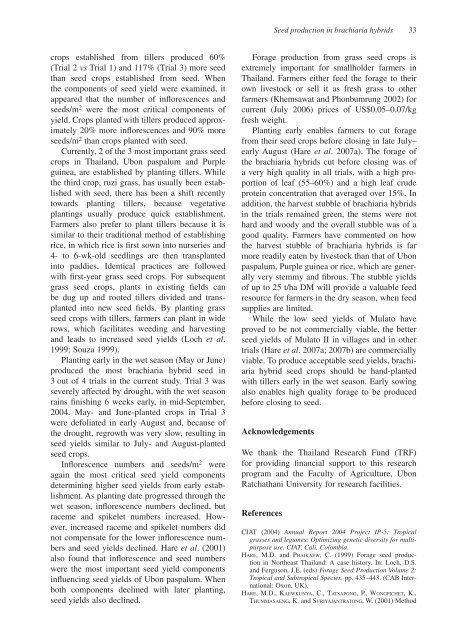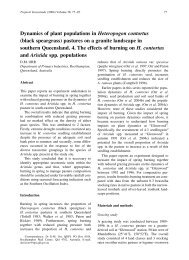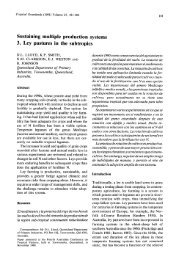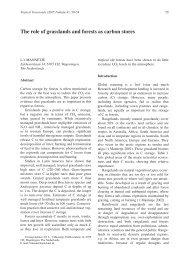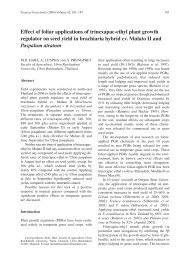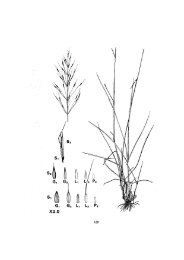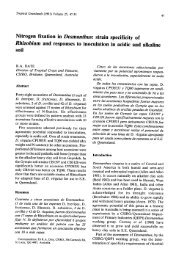Seed production of two brachiaria hybrid cultivars in - Tropical ...
Seed production of two brachiaria hybrid cultivars in - Tropical ...
Seed production of two brachiaria hybrid cultivars in - Tropical ...
Create successful ePaper yourself
Turn your PDF publications into a flip-book with our unique Google optimized e-Paper software.
<strong>Seed</strong> <strong>production</strong> <strong>in</strong> <strong>brachiaria</strong> <strong>hybrid</strong>s 33<br />
crops established from tillers produced 60%<br />
(Trial 2 vs Trial 1) and 117% (Trial 3) more seed<br />
than seed crops established from seed. When<br />
the components <strong>of</strong> seed yield were exam<strong>in</strong>ed, it<br />
appeared that the number <strong>of</strong> <strong>in</strong>florescences and<br />
seeds/m 2 were the most critical components <strong>of</strong><br />
yield. Crops planted with tillers produced approximately<br />
20% more <strong>in</strong>florescences and 90% more<br />
seeds/m 2 than crops planted with seed.<br />
Currently, 2 <strong>of</strong> the 3 most important grass seed<br />
crops <strong>in</strong> Thailand, Ubon paspalum and Purple<br />
gu<strong>in</strong>ea, are established by plant<strong>in</strong>g tillers. While<br />
the third crop, ruzi grass, has usually been established<br />
with seed, there has been a shift recently<br />
towards plant<strong>in</strong>g tillers, because vegetative<br />
plant<strong>in</strong>gs usually produce quick establishment.<br />
Farmers also prefer to plant tillers because it is<br />
similar to their traditional method <strong>of</strong> establish<strong>in</strong>g<br />
rice, <strong>in</strong> which rice is first sown <strong>in</strong>to nurseries and<br />
4- to 6-wk-old seedl<strong>in</strong>gs are then transplanted<br />
<strong>in</strong>to paddies. Identical practices are followed<br />
with first-year grass seed crops. For subsequent<br />
grass seed crops, plants <strong>in</strong> exist<strong>in</strong>g fields can<br />
be dug up and rooted tillers divided and transplanted<br />
<strong>in</strong>to new seed fields. By plant<strong>in</strong>g grass<br />
seed crops with tillers, farmers can plant <strong>in</strong> wide<br />
rows, which facilitates weed<strong>in</strong>g and harvest<strong>in</strong>g<br />
and leads to <strong>in</strong>creased seed yields (Loch et al.<br />
1999; Souza 1999).<br />
Plant<strong>in</strong>g early <strong>in</strong> the wet season (May or June)<br />
produced the most <strong>brachiaria</strong> <strong>hybrid</strong> seed <strong>in</strong><br />
3 out <strong>of</strong> 4 trials <strong>in</strong> the current study. Trial 3 was<br />
severely affected by drought, with the wet season<br />
ra<strong>in</strong>s f<strong>in</strong>ish<strong>in</strong>g 6 weeks early, <strong>in</strong> mid-September,<br />
2004. May- and June-planted crops <strong>in</strong> Trial 3<br />
were defoliated <strong>in</strong> early August and, because <strong>of</strong><br />
the drought, regrowth was very slow, result<strong>in</strong>g <strong>in</strong><br />
seed yields similar to July- and August-planted<br />
seed crops.<br />
Inflorescence numbers and seeds/m 2 were<br />
aga<strong>in</strong> the most critical seed yield components<br />
determ<strong>in</strong><strong>in</strong>g higher seed yields from early establishment.<br />
As plant<strong>in</strong>g date progressed through the<br />
wet season, <strong>in</strong>florescence numbers decl<strong>in</strong>ed, but<br />
raceme and spikelet numbers <strong>in</strong>creased. However,<br />
<strong>in</strong>creased raceme and spikelet numbers did<br />
not compensate for the lower <strong>in</strong>florescence numbers<br />
and seed yields decl<strong>in</strong>ed. Hare et al. (2001)<br />
also found that <strong>in</strong>florescence and seed numbers<br />
were the most important seed yield components<br />
<strong>in</strong>fluenc<strong>in</strong>g seed yields <strong>of</strong> Ubon paspalum. When<br />
both components decl<strong>in</strong>ed with later plant<strong>in</strong>g,<br />
seed yields also decl<strong>in</strong>ed.<br />
Forage <strong>production</strong> from grass seed crops is<br />
extremely important for smallholder farmers <strong>in</strong><br />
Thailand. Farmers either feed the forage to their<br />
own livestock or sell it as fresh grass to other<br />
farmers (Khemsawat and Phonbumrung 2002) for<br />
current (July 2006) prices <strong>of</strong> US$0.05–0.07/kg<br />
fresh weight.<br />
Plant<strong>in</strong>g early enables farmers to cut forage<br />
from their seed crops before clos<strong>in</strong>g <strong>in</strong> late July–<br />
early August (Hare et al. 2007a). The forage <strong>of</strong><br />
the <strong>brachiaria</strong> <strong>hybrid</strong>s cut before clos<strong>in</strong>g was <strong>of</strong><br />
a very high quality <strong>in</strong> all trials, with a high proportion<br />
<strong>of</strong> leaf (55–60%) and a high leaf crude<br />
prote<strong>in</strong> concentration that averaged over 15%. In<br />
addition, the harvest stubble <strong>of</strong> <strong>brachiaria</strong> <strong>hybrid</strong>s<br />
<strong>in</strong> the trials rema<strong>in</strong>ed green, the stems were not<br />
hard and woody and the overall stubble was <strong>of</strong> a<br />
good quality. Farmers have commented on how<br />
the harvest stubble <strong>of</strong> <strong>brachiaria</strong> <strong>hybrid</strong>s is far<br />
more readily eaten by livestock than that <strong>of</strong> Ubon<br />
paspalum, Purple gu<strong>in</strong>ea or rice, which are generally<br />
very stemmy and fibrous. The stubble yields<br />
<strong>of</strong> up to 25 t/ha DM will provide a valuable feed<br />
resource for farmers <strong>in</strong> the dry season, when feed<br />
supplies are limited.<br />
While the low seed yields <strong>of</strong> Mulato have<br />
proved to be not commercially viable, the better<br />
seed yields <strong>of</strong> Mulato II <strong>in</strong> villages and <strong>in</strong> other<br />
trials (Hare et al. 2007a; 2007b) are commercially<br />
viable. To produce acceptable seed yields, <strong>brachiaria</strong><br />
<strong>hybrid</strong> seed crops should be hand-planted<br />
with tillers early <strong>in</strong> the wet season. Early sow<strong>in</strong>g<br />
also enables high quality forage to be produced<br />
before clos<strong>in</strong>g to seed.<br />
Acknowledgements<br />
We thank the Thailand Research Fund (TRF)<br />
for provid<strong>in</strong>g f<strong>in</strong>ancial support to this research<br />
program and the Faculty <strong>of</strong> Agriculture, Ubon<br />
Ratchathani University for research facilities.<br />
References<br />
CIAT (2004) Annual Report 2004 Project IP-5: <strong>Tropical</strong><br />
grasses and legumes: Optimiz<strong>in</strong>g genetic diversity for multipurpose<br />
use. CIAT, Cali, Colombia.<br />
HARE, M.D. and PHAIKAEW, C. (1999) Forage seed <strong>production</strong><br />
<strong>in</strong> Northeast Thailand: A case history. In: Loch, D.S.<br />
and Ferguson, J.E. (eds) Forage <strong>Seed</strong> Production Volume 2:<br />
<strong>Tropical</strong> and Subtropical Species. pp. 435–443. (CAB International:<br />
Oxon, UK).<br />
HARE, M.D., KAEWKUNYA, C., TATSAPONG, P., WONGPICHET, K.,<br />
THUMMASAENG, K. and SURIYAJANTRATONG, W. (2001) Method


